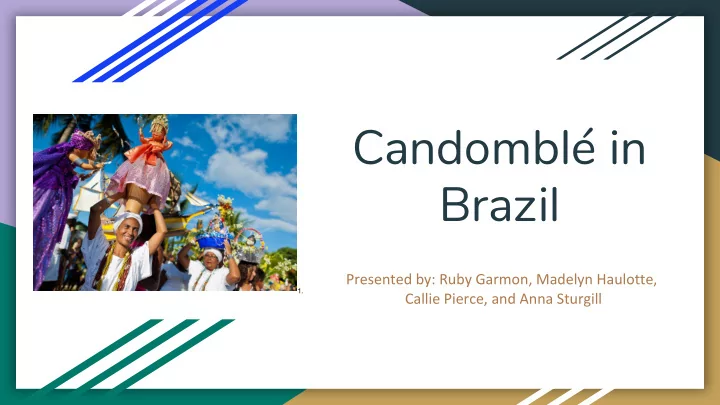

Candomblé in Brazil Presented by: Ruby Garmon, Madelyn Haulotte, 1. Callie Pierce, and Anna Sturgill
Candomblé in Brazil ● Similar to Haitian Vodou ● Allows women independence ● Matriarchal structures 1. 2.
What is Candomblé? ● Oludumaré (Olorun) ● Orixas ● Macumba 3. ● “ Dance in honor of the gods” ● Divination ● Pai-de-santo/Mãe-de-santo 4.
Historical Context ● Ethnic Groups 5. ● Portuguese Colonization ● Women Practitioners ● Repression through laws and police force 6.
Similarities to Haitian Vodou Practice of the religion: External Interpretations: ● ● Slavery Police repression in the 1920’s ● Orixas and 1930’s ● ● Initiation Brazil’s national image - racial ● Festa / spiritual possession democracy, free of racism ● Dance ● Consulations
Differences from Haitian Vodou ● Portuguese colonization / French colonization ● Geographic landscape ● Multicultural society
Evidence of Matriarchal Structures “...by tradition, women were uniquely suited to serve the African gods” (Matory 2005: 190) “...a decision to serve the spirits becomes a decision to stop serving men” (McCarthy Brown 2001: 167) Marcelina da Silva Mama Lola ● ● Casa Branca Four generations of Priestesses ● ● Social mobility Social mobility ● ● Wealth and power Wealth through religious practice
Conclusion ● Historical Context ● Relations to Haitian Vodou ● Matriarchal Structures ● Means of Independence ● Feminist Theory 7.
Works Cited Boyce, D. C. 2008. Encyclopedia of the African Diaspora: Origins, Experiences, and Culture . Santa Barbara, Calif: ABC-CLIO. Retrieved Nov. 19, 2017. Castillo, Lisa Earl and Luis Nicolau Pares. March 2010. “Marcelina da Silva: A Nineteenth-Century Candomblé Priestess in Bahia.” vol. 31, no. 1. 1-27. Retrieved November 16, 2017. Garcia-Navarro, Lulu. 2013. NPR. “Brazilian Believers Of Hidden Religion Step Out Of Shadows.” Retrieved Nov. 19, 2017 (https://www.npr.org/sections/parallels/2013/09/16/216890587/brazilian-believers-of-hidden-religion-step-out-of-shadows). Matory, J. Lorand. 2005. Black Atlantic Religion: Tradition, Transnationalism, and matriarchy in the Afro-Brazilian Candomblé . Princeton: Princeton University Press. McCarthy Brown, Karen. 1991. Mama Lola . Berkeley and Los Angeles: University of California Press. Johnson, P. 2002. Secrets, Gossip, and Gods: The Transformation of Brazilian Candomblé. Oxford: Oxford University Press. Parés, L., & Vernon, R. 2013. In The Formation of Candomblé: Vodun History and Ritual in Brazil. Chapel Hill: University of North Carolina Press. Selka, S. August 2007. Nova Religio: The Journal of Alternative and Emergent Religions. Mediated Authenticity: Tradition, Modernity, and Postmodernity in Brazilian Candomblé,11(1), 5-30. Retrieved Nov. 19, 2017. Voeks, Robert A. 1997. Sacred Leaves of Candomblé. Austin: University of Texas Press.
Image Citations Sochor, Jan. 2012. “Yemanjá: Candomblé cult in Bahia.” Retrieved Nov. 7, 2017 1. (https://www.jansochor.com/photo-blog/yemanja-candomble-cult-bahia-brazil). Santos, Giselle. 2015. “Candomble: The African-Brazilian Dance in Honor of the Gods.” Retrieved Nov. 14, 2017 2. (http://www.ancient-origins.net/history-ancient-traditions/candomble-african-brazilian-dance-honor-gods-004596 ). Voeks, Robert A. 1997. Sacred Leaves of Candomblé. Austin: University of Texas Press. 3. Santos, Giselle. 2015. “Candomble: The African-Brazilian Dance in Honor of the Gods.” Retrieved Nov. 14, 2017 4. (http://www.ancient-origins.net/history-ancient-traditions/candomble-african-brazilian-dance-honor-gods-004596 ). Garcia-Navarro, Lulu. 2013. NPR. “Brazilian Believers Of Hidden Religion Step Out Of Shadows.” Retrieved Nov. 19, 2017 5. (https://www.npr.org/sections/parallels/2013/09/16/216890587/brazilian-believers-of-hidden-religion-step-out-of-shadows). Parés, L., & Vernon, R. 2013. In The Formation of Candomblé: Vodun History and Ritual in Brazil. Chapel Hill: University 6. of North Carolina Press. Voeks, Robert A. 1997. Sacred Leaves of Candomblé. Austin: University of Texas Press. 7.
Recommend
More recommend